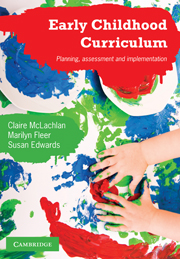Book contents
- Frontmatter
- Contents
- List of figures
- List of tables
- About the authors
- Acknowledgments
- Chapter 1 Introduction
- Chapter 2 Theory, research and the early childhood curriculum
- Chapter 3 Development and learning – how views of development shape how curriculum is framed
- Chapter 4 Curriculum as a cultural broker
- Chapter 5 Interpreting early childhood curriculum
- Chapter 6 Cultural-historical curriculum in action
- Chapter 7 Curriculum as a conceptual tool: Observation, content and programming
- Chapter 8 Assessing children and evaluating curriculum: Shifting lenses
- Chapter 9 Content knowledge: The sciences, maths and numeracy
- Chapter 10 Content knowledge: Language, literacy and ICT
- Chapter 11 Content knowledge: The arts and health, wellbeing and physical activity
- Chapter 12 Conclusions
- Index
Chapter 2 - Theory, research and the early childhood curriculum
- Frontmatter
- Contents
- List of figures
- List of tables
- About the authors
- Acknowledgments
- Chapter 1 Introduction
- Chapter 2 Theory, research and the early childhood curriculum
- Chapter 3 Development and learning – how views of development shape how curriculum is framed
- Chapter 4 Curriculum as a cultural broker
- Chapter 5 Interpreting early childhood curriculum
- Chapter 6 Cultural-historical curriculum in action
- Chapter 7 Curriculum as a conceptual tool: Observation, content and programming
- Chapter 8 Assessing children and evaluating curriculum: Shifting lenses
- Chapter 9 Content knowledge: The sciences, maths and numeracy
- Chapter 10 Content knowledge: Language, literacy and ICT
- Chapter 11 Content knowledge: The arts and health, wellbeing and physical activity
- Chapter 12 Conclusions
- Index
Summary
In the first chapter it was noted that early childhood teachers are often confused by the term ‘curriculum’ because of the different ways this term is used, as noted by Kiri, Kelly, Gemma and Anna:
Kiri: Most countries have some type of written curriculum document. Surely the people who wrote those documents knew what they were on about?
Gemma: But aren't those documents just a guide to what we do in the classroom? I don't think that our curriculum – Te Whāriki – is very specific about the actual stuff I will do with children every day.
Kelly: Isn't the curriculum how you plan the environment, and sort of based on your own national curriculum and the sorts of things it says that children should experience?
Anna: But on my last teaching practice, my Associate Teacher told me that the curriculum was in her head and that she didn't take much notice of the curriculum she was using. She said that she just uses the curriculum as a source for ideas and then the real curriculum is designed on the trot as she interacts with children.
In this chapter we seek to unpack some of the ideas put forward by Kiri, Gemma, Kelly and Anna through introducing you to conceptual knowledge about curriculum, as well as through examining fundamental principles of curriculum design. The term ‘curriculum’ is defined and the major philosophical and theoretical positions that underpin modern conceptions of early childhood curriculum are examined.
- Type
- Chapter
- Information
- Early Childhood CurriculumPlanning, Assessment, and Implementation, pp. 8 - 33Publisher: Cambridge University PressPrint publication year: 2010



